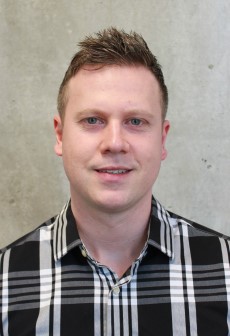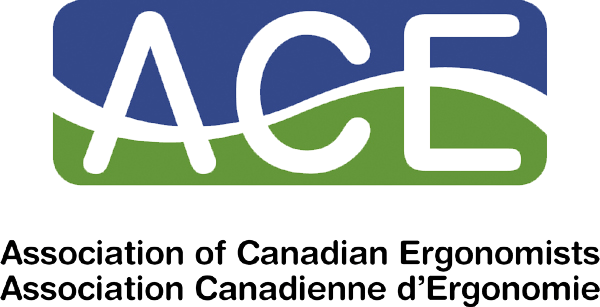
What is your name, educational path and current profession?
My name is Nick La Delfa, and I am an Associate Professor in the Faculty of Health Sciences at Ontario Tech University, with a research focus in occupational biomechanics, neuromechanics and ergonomics. I started my educational journey back at McMaster University, where I completed my undergrad in Kinesiology. I continued with my Master's and Doctoral degrees at McMaster, under the supervision of Dr. Jim Potvin. My grad work spanned a couple of areas relevant to ergonomics & human factors (e.g., neuromuscular fatigue, motor behaviour, dental hygiene ergonomics), but my primary focus was on strength capability research — ultimately culminating in the Arm Force Field ergonomics tool. After graduating from McMaster in 2016, I completed a postdoctoral fellowship at the University of Waterloo, working in Dr. Clark Dickerson's lab focused on shoulder biomechanics. Since 2017, I’ve been a faculty member at Ontario Tech and direct the Occupational Neuromechanics and Ergonomics Lab (or the ONE lab, for short).
How long have you been an ACE member?
I have been an ACE member since 2011, when I attended my first annual meeting in London, Ontario as a PhD student in Dr. Potvin’s lab.
Are you engaged in any current research?
Yes, our research group definitely has a few projects on the go. I would say the primary objective and passion of our lab is to advance proactive ergonomics assessments. Traditionally, ergonomics has been a reactive discipline, where interventions are put into place after some issue is identified or injuries have already occurred. My focus is helping us move towards a more proactive ergonomics process, using simulation to study ergonomics factors before they become issues. In some cases, proactive evaluations can be done years before the product or operations ever exists in reality. You can imagine the significant potential for cost savings with this approach!
In our lab, we’re working towards this goal by further understanding and developing predictive models of human strength and fatigue/recovery. We’ve now conducted several studies that have examined how factors such as handedness, arm of exertion and extended reaching might affect manual strength capability. Michael Watterworth, a PhD student in my lab, is conducting a series of studies to define ergonomics exposure thresholds for over-shoulder work. Another PhD student, Ryan Foley, is trying to understand the complexities of muscle fatigue and recovery at the neurophysiological level, then applying these research findings within a computational model of muscle fatigue (originally developed by Dr. Potvin and his colleague, Dr. Andy Fuglevand). This is a snapshot of some of the current laboratory work aimed at improving the fidelity of our ergonomics assessments, but we’re also conducting research on how emerging technology, including lower-cost motion capture and virtual reality systems, can facilitate proactive ergonomics assessments and perhaps make them more accessible to all practicing ergonomists.
How did you first become interested in ergonomics?
I actually started my undergraduate studies with every intention of becoming a dentist - largely influenced by my father's legacy, who passed away when I was young. During my third year of studies, I blindly enrolled in an ergonomics course offered by Dr. Potvin - mainly because I did well in his biomechanics course a year earlier. Needless to say, I was hooked… I loved the problem-solving nature of ergonomics, and how it forced you to think differently than all the other courses I was taking. In the following year, Dr. Potvin was kind enough to supervise me in an undergrad thesis project on the topic of dental ergonomics – combining both of my passions at the time. Since these early days, I knew I wanted to be an ergonomics researcher and I haven’t looked back since.
What didn’t you learn in school that you wish you had?
While my education certainly provided a solid foundation in several topics important to ergonomics, the nuanced challenge of effectively managing multiple projects and deadlines was probably the biggest challenge I faced. Looking back, I think I would have benefited from taking more courses in business, finance and project management. It also would have been great if I had an opportunity to do a field-placement or internship, allowing me to apply some of my knowledge and skills in the real world for an extended period of time.
What is your favorite aspect of being an ergonomist? What is your favorite aspect of being involved in ergonomics?
My favorite thing about ergonomics is its multidisciplinary nature. It allows me to apply and integrate my knowledge in biomechanics, psychology, physiology, statistics and so much more. I also love the problem-solving nature of ergonomics. It requires using available tools to gather evidence and make informed decisions and recommendations. When the evidence or tools are lacking, there is a willingness within our community to support new research efforts, which is something I love about our community and has me excited to come to work every day.
What do you see as the biggest opportunity for ergonomists in the future?
Based on some of my previous answers, it is probably no shock that I think proactive ergonomics is a massive opportunity moving forward. Embracing cutting-edge simulation and digital human modeling methods allows us to preemptively assess ergonomic factors before they manifest as issues. While this approach demands an upfront investment, the potential to prevent injuries and realize significant cost savings holds massive potential. I realize that access to some of these methods has been a barrier so far, but I think some of the emerging technology in our field will allow for ergonomists in smaller consulting firms or businesses to start incorporating proactive ergonomics within their practice at a lower cost.
What advice would you give to a student or young professional starting out in ergonomics?
My best advice would be to ensure that you always maintain a high standard in whatever you do. Consistency and dependability are traits that will get you far in all walks of life. Strive to be a person that always adds value to your team. That could mean showing leadership within your group, supporting your peers when they need a helping hand, or being that all important “closer” or “finisher”. Being a person who just gets the job done, without having to be chased or followed up on too often, is a fantastic reputation to have. Getting that job done, and having it be of a consistently high-quality every time, makes you invaluable - and pretty much unstoppable.
Is there anything else you would like to share that we have missed?
I guess one thing we could work on in ergonomics is self-promotion. There are so many potential benefits to having good ergonomics principles infused within all levels of an organization, and even at the personal level. The general population certainly came to appreciate this during the pandemic, where so many people came to realize how their poor home workstations were negatively affecting their productivity, mental health, and physical well-being (even I had an achy back after too many sofa writing periods). I think general knowledge of ergonomics is really helpful on the individual level as well as the population level, and we need to do whatever we can to make this obvious to everyone. Related to this, I think we need to continue to push our professional designations and have more individuals become certified as professional ergonomists. This is something I’ve been guilty of putting off, as well. There have been very few instances, at least in my career as a professor, where not being a professional certified ergonomist has held me back in any way. That being said, if we can get to a place where all ergonomics educators and practitioners are mandated to have this certification in place, similar to our engineering colleagues, I really think this will help turbo-charge our profession and make ergonomics a “must have” for all organizations.
